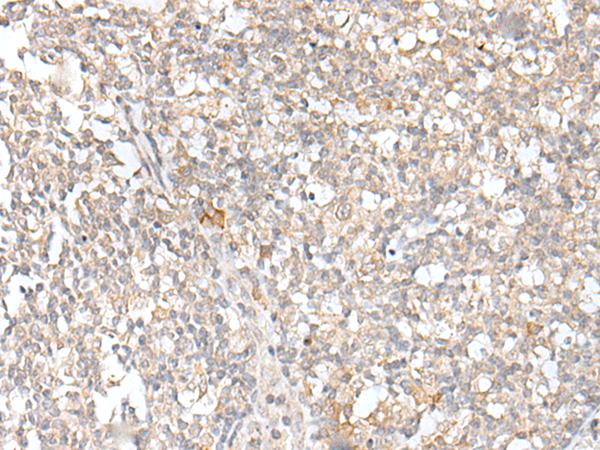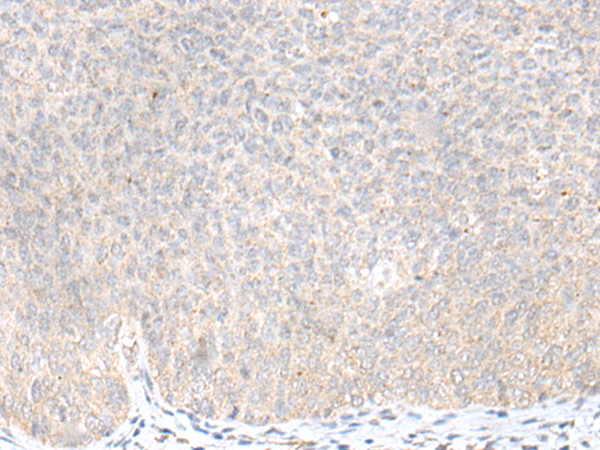

| WB | 咨询技术 | Human,Mouse,Rat |
| IF | 咨询技术 | Human,Mouse,Rat |
| IHC | 1/25-1/100 | Human,Mouse,Rat |
| ICC | 技术咨询 | Human,Mouse,Rat |
| FCM | 咨询技术 | Human,Mouse,Rat |
| Elisa | 1/5000-1/10000 | Human,Mouse,Rat |
| Aliases | NKG2E; NKG2-E |
| Host/Isotype | Rabbit IgG |
| Antibody Type | Primary antibody |
| Storage | Store at 4°C short term. Aliquot and store at -20°C long term. Avoid freeze/thaw cycles. |
| Species Reactivity | Human |
| Immunogen | Synthetic peptide of human KLRC3 |
| Formulation | Purified antibody in PBS with 0.05% sodium azide and 50% glycerol. |
+ +
以下是3篇关于KLRC3抗体的参考文献概览:
---
1. **文献名称**:*KLRC3 antibody reveals distinct NK cell subsets in chronic viral infection*
**作者**:Smith A, et al.
**摘要**:研究利用KLRC3特异性抗体,通过流式细胞术分析慢性HCV感染者外周血NK细胞亚群,发现KLRC3高表达与细胞毒性功能增强相关,提示其作为NK细胞活化标志物的潜力。
---
2. **文献名称**:*Structural characterization of KLRC3 receptor using monoclonal antibodies*
**作者**:Zhang L, et al.
**摘要**:开发了针对KLRC3胞外域的单克隆抗体,通过X射线晶体学解析表位结合模式,证实抗体可阻断KLRC3与HLA-E分子的相互作用,为免疫治疗提供工具。
---
3. **文献名称**:*KLRC3 antibody-based profiling in tumor-infiltrating lymphocytes*
**作者**:Wang Y, et al.
**摘要**:利用KLRC3抗体对多种实体瘤微环境中的淋巴细胞进行免疫组化分析,发现KLRC3+ NK细胞浸润水平与患者预后改善显著相关,支持其在肿瘤免疫监视中的作用。
---
如需具体文献链接或补充更多研究,可进一步说明需求。
The KLRC3 antibody targets the protein encoded by the Killer Cell Lectin-Like Receptor Subfamily C, Member 3 (KLRC3) gene, a member of the natural killer (NK) cell receptor family. KLRC3. also known as NKG2E, is a C-type lectin-like transmembrane protein predominantly expressed on NK cells and subsets of T lymphocytes. It plays a role in immune regulation by interacting with HLA-E molecules on target cells, a mechanism critical for recognizing cellular stress, viral infection, or malignant transformation. KLRC3 forms heterodimers with CD94. enabling it to transmit activation or inhibition signals depending on the HLA-E-bound peptide, thereby modulating NK cell cytotoxicity and cytokine production.
Antibodies against KLRC3 are essential tools for studying NK cell biology, immune responses, and disease mechanisms. They are widely used in flow cytometry to identify and isolate NK cell populations, in immunohistochemistry to map protein expression in tissues, and in functional assays to dissect receptor-ligand interactions. Research involving KLRC3 antibodies has shed light on their roles in viral infections (e.g., HIV, hepatitis), cancer immunotherapy, and autoimmune disorders. However, KLRC3's exact functional dichotomy—balancing activating versus inhibitory signaling—remains under investigation, partly due to genetic variations and splice isoforms. These antibodies also hold potential in developing diagnostic biomarkers or therapeutic strategies targeting NK cell-mediated immunity.
×